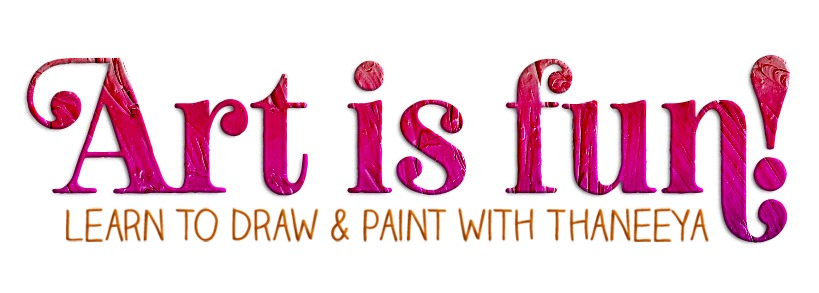Paint Brushes for Acrylics
Which paintbrushes do I need to start painting with acrylics?
The kind of paintbrush that you use can make all the difference in how well your painting turns out. Some brushes are more suited to particular techniques than others. So, how do you know which paintbrushes to choose?
First, familiarize yourself with the 8 different kinds of paintbrushes recommended for use with acrylics. This Acrylic Paint Brush Guide will explain what each type of brush is used for. Narrow down which paintbrushes you will need based on the size and style of painting you would like to do.
In general, if you're just starting out with acrylics and you're on a tight budget, I'd recommend getting one round and one flat brush. That's enough to accomplish most of what you need with acrylics. Two brushes is really all you need to get started with acrylics. Then if you decide you like it, you can go out and buy more artist paint brushes!
If you're buying paintbrushes for the first time, I suggest going to your local art supply store and seeing them in person first. This will allow you the opportunity to see the wide variety for yourself. Then, once you've fallen in love with certain artist paint brushes, you'll know exactly what to get if you want to buy them online.
At the store, you can pick up the artist paint brushes and run your fingers along the bristles, getting a feel for the different types of hairs. Some bristles stay firmly in place, while others are floppy. Some are soft to the touch, while others are stiff and coarse. For acrylics, you'll usually want something that is between the softness of a watercolor brush and the coarseness of an oil painting brush.
To select a paintbrush, hold it in your hand and see how it feels. Check the bristles as described above. When you settle on a brush that "feels right" to you, check to make sure that it doesn't have any stray or frayed hairs. If it does, put it back and get another one.
Should I get a paintbrush with natural hairs or synthetic hairs?
For acrylics, it's better to get artist paint brushes with synthetic hairs. These hairs are made from a polyester called Taklon. They will stay stiffer than natural hairs when they are wet. In addition, the chemicals in acrylic paint can have an adverse affect on artist paint brushes with natural hairs, and in some cases, they can become ruined. If that's not enough to convince you, just ask yourself: would you really want to paint with a brush whose hairs were plucked from the back end of a pig? (That's what hog bristles are!)
Do I need a brush with a long handle or a short handle?
The handles of acrylic paintbrushes can be long or short. The short ones are about the length of a pencil, so they feel quite natural in one's hand. The long ones can be as long as a 12-inch ruler, making it a bit awkward for those who aren't used to it.
The main difference between the two is that long-handled brushes are intended for easel work, when you want to stand away from the painting, rather than close-up. The length of the handle allows you more distance from the painting surface. In contrast, short handles allow for easier close-up work. I usually prefer short handles, because I prefer to work up close. Choose your own brushes based on your own work preference!
What size paint brush should I get?
Now what about sizes? Brushes come in an assortment of sizes, from teeny tiny to super large. For total beginners, I suggest getting a medium or average size brush - somewhere in the middle. Don't overwhelm yourself with a huge monster of a paintbrush, and don't strain yourself with a microscopic paintbrush!
Settling on the right one will depend on your personal artistic needs. Just use common sense when buying your brushes, and you'll be fine.
Paint brush sizes vary from brand to brand, meaning that a size 0 round in one brand may differ from a size 0 round in another brand. Because there is no industry standard regulating the brush sizes, if you decide to switch brands and you want the same size as your previous brush, it's best to handle brushes in person so you'll know exactly what you're getting.
What brands of paintbrushes do you recommend for beginners?
I'll tell you a little secret: I don't buy expensive brushes. All my artwork is created with brushes that cost less than $5. Some of them, less than $2. With proper care, they can last several months. When one gets frayed, I simply set it aside to use on abstract artwork. I almost never throw away paintbrushes! They will always find some use, somewhere, somehow.
The Recommended Products below are there to help you browse for art supplies, and if you make a purchase we get a small commission that supports this site and keeps it FREE! Thanks in advance.
Princeton and Loew Cornell are two of my favorite paintbrush brands. They are inexpensive yet good quality.
Da Vinci brushes are more expensive, but worth the cost. These paintbrushes have bristles that are extra stiff and rugged, allowing them to hold and absorb more paint. This makes them an excellent choice for thick, impasto-style painting.
Art is Fun Paintbrush Guide
Page 1........ describes the different types of brushes for acrylics and what each paintbrush can do.
Page 2........ answers all the questions that a beginning artist will have about paintbrushes.
Page 3........ explains how to safely care for your paintbrushes and keep them happy.
Page 4........ demonstrates the best way to clean, store and transport your paintbrushes.
read more...
Find out what acrylic painting supplies you should get if you want to get started with acrylic paintings. If you're a total beginner to painting with acrylics, learn what paints are best for you!
Return to the Acrylic Table of Contents page, where you'll find all kind of info and tutorials about painting with acrylics!









